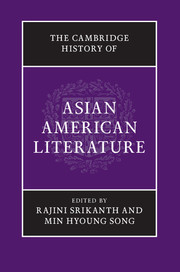Book contents
- The Cambridge History ofAsian American Literature
- The Cambridge History of Asian American Literature
- Copyright page
- Contents
- Notes on Contributors
- Introduction
- Part I Early Forms of Expression to the Start of the Twentieth Century
- Part II The Exclusion Era, World War II, and the Immediate Postwar Era
- 5 Indian Diasporic Autobiography: New Nations and New Selves
- 6 Koreans in Exile: Younghill Kang and Richard E. Kim
- 7 Filipino and Filipina Voices
- 8 Chinatown Life as Contested Terrain: H. T. Tsiang, Jade Snow Wong, and C. Y. Lee
- 9 Coded Critiques: Japanese American Incarceration Literature
- 10 Asian American Short Fiction and the Contingencies of Form, 1930s–1960s
- 11 The Chicago School and the Sociological Imagination
- Part III The Asian American Movement
- Part IV Canons
- Part V Post-1965 and the Twenty-First Century
- Part VI Twenty-First Century: 9/11, Empire, and Other Challenges to Literature
- Bibliography
- Index
10 - Asian American Short Fiction and the Contingencies of Form, 1930s–1960s
from Part II - The Exclusion Era, World War II, and the Immediate Postwar Era
Published online by Cambridge University Press: 05 December 2015
- The Cambridge History ofAsian American Literature
- The Cambridge History of Asian American Literature
- Copyright page
- Contents
- Notes on Contributors
- Introduction
- Part I Early Forms of Expression to the Start of the Twentieth Century
- Part II The Exclusion Era, World War II, and the Immediate Postwar Era
- 5 Indian Diasporic Autobiography: New Nations and New Selves
- 6 Koreans in Exile: Younghill Kang and Richard E. Kim
- 7 Filipino and Filipina Voices
- 8 Chinatown Life as Contested Terrain: H. T. Tsiang, Jade Snow Wong, and C. Y. Lee
- 9 Coded Critiques: Japanese American Incarceration Literature
- 10 Asian American Short Fiction and the Contingencies of Form, 1930s–1960s
- 11 The Chicago School and the Sociological Imagination
- Part III The Asian American Movement
- Part IV Canons
- Part V Post-1965 and the Twenty-First Century
- Part VI Twenty-First Century: 9/11, Empire, and Other Challenges to Literature
- Bibliography
- Index
Summary
Keywords
- Type
- Chapter
- Information
- The Cambridge History of Asian American Literature , pp. 187 - 202Publisher: Cambridge University PressPrint publication year: 2015



